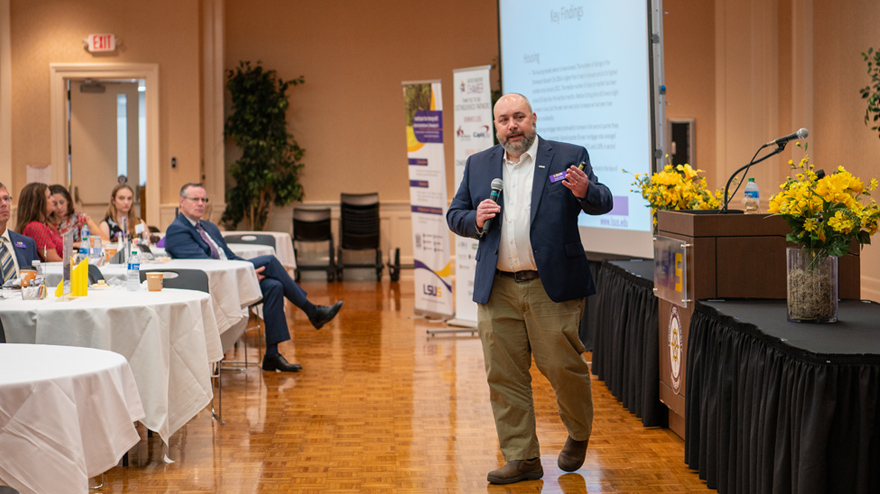The availability of affordable housing is an issue across the country, but for Louisiana’s lowest earners, the rental market is experiencing a severe shortage.
LSUS’s Center for Business and Economic Research released a report in which nearly half of Louisiana renters (48.4 percent) are cost-burdened, meaning these households spend more than 30 percent of their income on housing.
Of those cost-burdened households, more than half (55.2 percent) are extremely cost-burdened, meaning these households spend more than 50 percent of their income on housing.
“It’s an ongoing problem, not just here in Louisiana but across the state and the country,” said Douglas White, director of LSUS’s Center for Business and Economic Research, who co-authored the study with College of Business Dean Dr. Mary Lois White. “This is especially true if you fall in the extremely low income or very low income bracket – you’re going to have trouble finding housing and not be cost-burdened, or even more likely, extremely cost-burdened.”
The study uses data from the 2023 American Community Survey. It segments Louisiana into 11 regions anchored by its own Metropolitan Statistical Area and calculates that region’s area median income (AMI).
Each region’s area median income divides the population into five income categories – extremely low income (0 to 30 percent of AMI), very low income (30 to 50 percent), low income (50 to 80 percent), moderate income (80 to 120 percent) and upper income (more than 120 percent).
For the Shreveport-Bossier region, 46 percent of all renter households are cost-burdened, which increases to 82 percent of very low income rental households and nearly 69 percent of extremely low income rental households.
That’s compared to statewide rates that include 79 percent of very low income rental households and 72 percent of extremely low income rental households that are cost-burdened.
Douglas White said when this much of household income is tied up in rent, not much is left for other expenses.
“If you’re spending more than 30 to 50 percent of your income on rent, that’s less money that you have to spend on other things,” White said. “You’re not going out to eat, you’re not buying clothes from the store – you’re not doing those kinds of things.
“This also prevents you from saving, and that’s negative because you have no cushion. If you hurt yourself, or your car breaks down, or your water heater goes out – it makes it more difficult for you to meet those unexpected expenses.”
Availability of affordable housing units is another piece to the puzzle.
While every measured region contained enough units statistically for tenants in the three lowest income brackets combined, whenever the data measures affordable units for just the very low income and extremely low income households, those statistics come up short.
In the Shreveport-Bossier area, there are less than 60 affordable units per 100 tenants in the extremely low income category and just over 80 in the very low income category per 100 tenants.
The Baton Rouge and New Orleans areas experienced the most severe shortages of affordable units for the bottom two income categories.
At the state level, less than 65 affordable units exist per 100 tenants in the extremely low income category and about 90 units per 100 tenants in the very low income category.
White said there’s a pattern of some higher-level income tenants “renting down,” which exacerbates the shortage of affordable units.
“Let’s say a household makes 100 percent of the area median income, and they are renting a unit that’s affordable for a household at the 80 percent level,” White said. “There are a lot of good reasons to do that – a family might be saving money toward a down payment on a house or a car or private school tuition.
“But the problem is now that unit isn’t available to a tenant who is in that income bracket, and they might be forced to rent up and become cost-burdened or extremely cost-burdened.”
The current economic climate with its rising interest rates makes building more affordable units difficult.
“I’ve talked to builders, and one of the problems they always point out is that they have to build to certain level to make it economically viable to break even on costs associated with the building,” White said. “Obviously higher interest rates and higher input costs (building materials, etc.) raises the level to which a builder would need to construct to break even.
“And if you have any kind of housing program assistance, and those costs go up faster than your budget, that’s fewer households that you can help.”
This report relies on data collected through the American Community Survey, which is conducted by the United States Census Bureau.
The Bureau is one of many federal agencies that are going through staff reductions and budget cuts at the federal level, which puts surveys like ACS at risk.
“We are able to produce a pretty current look at the local housing environment using ACS data,” White said. “And it’s not just housing studies, there are a number of studies that rely on the ACS.”
For the full report detailing the rental market in Shreveport-Bossier and all 11 regions across the state, visit the Center for Business and Economic Research website.



